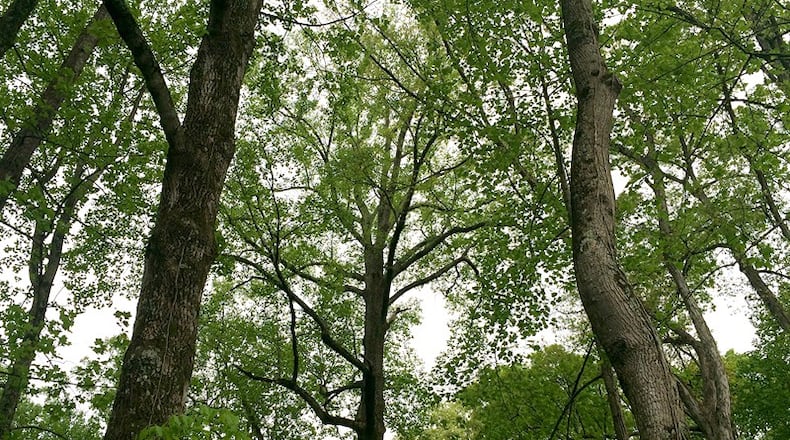The city of Atlanta is looking to take another whack at fixing its Tree Protection Ordinance.
That's great, because anyone who has been around the redeveloping city knows that trees are anything but protected.
Properties are getting cleared and older homes bulldozed to make way for McMansions or "Townhomes from the 500s!" The grrrrr of chainsaws competes with the sounds of songbirds and traffic.
» FROM 2016 | 20 Atlanta trees you should know
Department of City Planning czar Tim Keane explained to me how the word “protection” in the Tree Protection Ordinance is a misnomer: “The ordinance doesn’t protect trees. It makes you pay for it.”
By “it,” he means chopping them down. It’s called the “recompense fund” and costs about $1,000 to cut down an oak that’s 30 inches in diameter at chest height, basically a rounding error on a $500,000 townhouse. Developers, Keane said, “write a check and they build.”
That makes sense, because Atlanta has always been a transactional town.
To help change that, the city last year hired a consulting firm to conduct an “urban ecology” analysis. This studied rivers and creeks, tree canopies, floodplains and green spaces to determine how Atlanta can achieve a goal of 50 percent tree canopy.
Atlanta, widely known as “The City in a Forest Too Busy to Hate,” has a 47 percent tree canopy, which is not bad, according to a Georgia Tech analysis from 2014. But — and this is a big but — lots of trees have been mulched since then and some of that 47 percent was actually junk shrubs and kudzu growing on empty lots.
The ecology study, presented at public meetings in late April, showed an emphasis on saving clusters of trees and corridors of vegetation along rivers and creeks. Most of these so-called valued stands to be protected looked to be in the northwest, southwest and southeast corners of the city.
That caused Laura Dobson, a resident who lost a battle against a tree massacre in her Garden Hills neighborhood two years ago, to remark that her north Atlanta community didn't seem to be protected.
“I just can’t shake the feeling that the core of Atlanta was punted to save the waterways,” she told me after the meeting. “I’m all for these corridors, but not at the exclusion of my neighborhood trees, or anyone else’s neighborhood trees.”
The problem is that trees are not being lost in some stream beds we don’t often visit. It’s block by block, lot by lot, where people live and where trees are falling for infill development and fancy upgrades. It’s an ironic twist. People want to move to neighborhoods because of the wooded feel — and then they clear their property to build their home.
Community advocate deLille Anthony, a co-founder of the group The Tree Next Door, notes that the developer who largely clear-cut a property along DeKalb Avenue is now touting the 42 homes squeezed onto the site as being in "Atlanta's leafy east side."
"They mean the leafy atmosphere of other people's property," said Anthony. "If everyone does what they're doing, there will be nothing left."
Keane, the planning commissioner, said the urban ecology study allows the city to look at the big picture and “ground the tree ordinance conversation in an analyses of the environment of the city.”
He said the new ordinance would identify important species of trees to retain and would value saving stands of trees. Currently, the arborist comes in on the tail end of the site development permitting process. Keane wants to flip that around.
“High-value trees would be protected and you design (buildings) around them,” he said.
Keane said the city wants a "predictable and consistent process." The 32-page ordinance is squishy, and Keane said that has created an "arduous" system that often has builders tied up for long periods as residents file appeals. A new, more straightforward process might fix that, he said.
“If we have an ordinance that protects trees, then we shouldn’t need an appeal,” he said.
When I mentioned that to Anthony, I could hear her teeth grind over the phone.
“We have to save the appeals process because we have too many examples where the city arborist got things wrong,” she said. Anthony estimated being involved in about two dozen appeals and failing only once.
Van Hardimon, the inner-Atlanta chapter president of the Greater Atlanta Home Builders Association, said builders worry about “not having a voice in the rewrite.”
Hardimon, who as a builder focuses on mid-range homes in the city, said builders often get bogged down in red tape or get sidelined by residents who appeal during permitting. He said the rewrite of the ordinance may make it difficult and more expensive to build homes. This would thwart the city’s goal to build more affordable housing, a pressing issue in which longtime residents, often black, are getting priced out of the city.
Hardimon, who is black, said the more affluent the neighborhood, the more builders get pushback from residents about cutting down trees. “In some neighborhoods (where he works), people are just glad to see something happening,” he said.
But city Councilwoman Natalyn Archibong, whose east side district has seen waves of infill, countered Hardimon's contention that less-affluent areas are not as concerned about tree preservation.
“Environmental justice should be the same in all parts of the city,” she said.
Councilman Howard Shook said chainsaws biting into trees cause a “visceral reaction” in many people, which makes this issue contentious and difficult to resolve. He is skeptical the city can iron out an ordinance that will make both environmentalists and developers happy.
“When do you ever see government try to simplify an ordinance when it doesn’t get twice as complicated?” he said.
The process is supposed to finish up in late summer, not long before the leaves change color.
About the Author
The Latest
Featured





